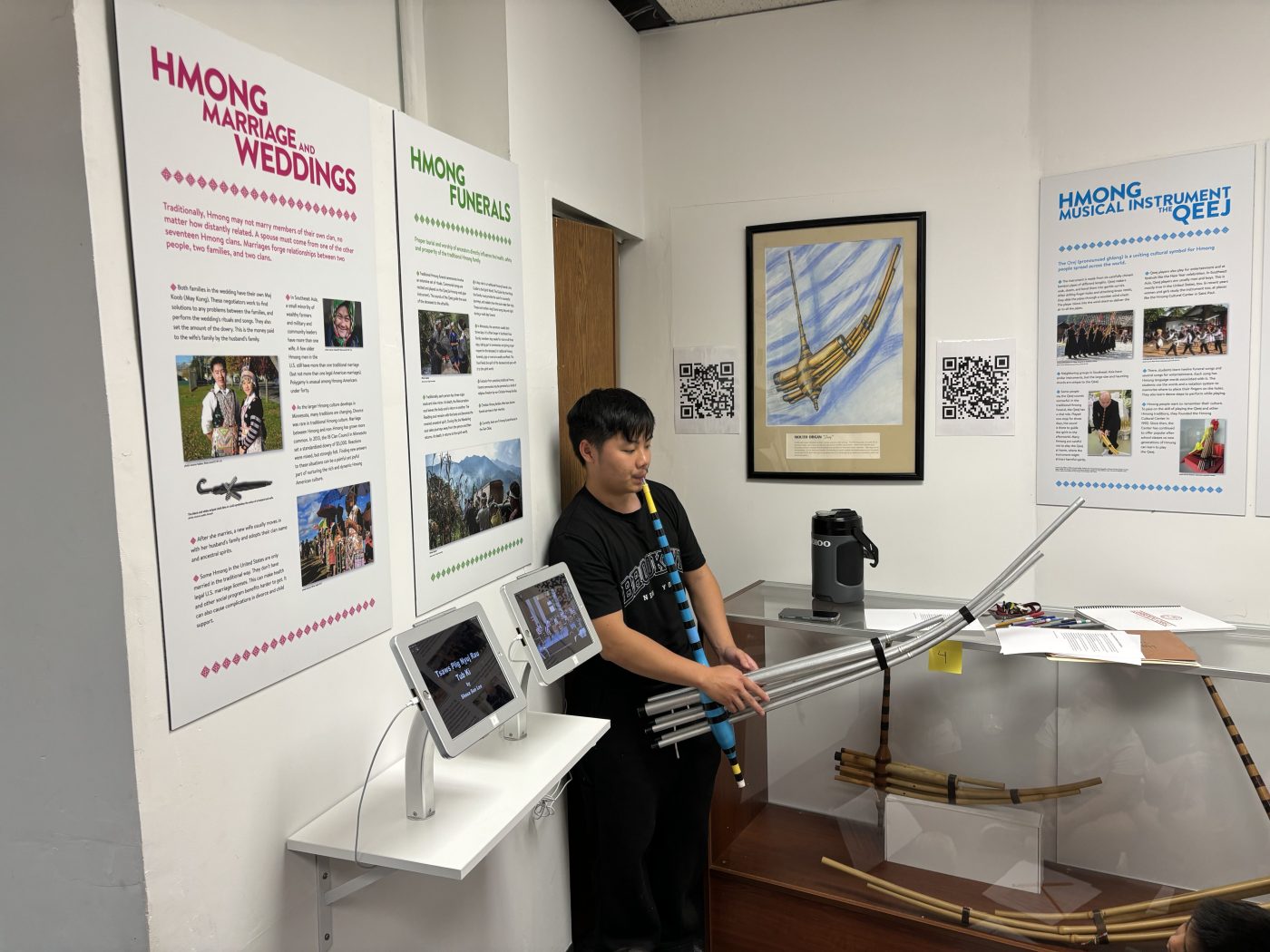
St. Paul: With recent expansion, Hmong Cultural Center Museum now spans more than 2,000 square feet
The Hmong Cultural Center Museum in St. Paul, one of few public institutions dedicated to displaying Hmong material culture and history, is growing.
The museum, which opened its storefront exhibition space in 2021, has just finished an expansion that increases its footprint by two-thirds, to about 2,000 total square feet.
Visitors can tour the expanded museum for free during an open house, from 3 to 5 p.m. Tuesday. Regular hours are from 10 a.m. to 4 p.m. daily, with a $7 admission fee per person.
Hmong Cultural Center program director Mark Pfeifer and executive director Txongpao Lee pose for a photo next to a display of story cloths and flower cloths at the museum on University and Western Avenues in St. Paul on Tuesday, Dec. 28, 2021. (John Autey / Pioneer Press)
The Hmong Cultural Center, founded in 1992, has been headquartered for the past decade or so in second-floor offices near Western and University avenues. The center provides a variety of support services for the Hmong community as well as research and education programs aimed both at Hmong and non-Hmong people.
Even before the street-level museum opened in 2021, a few rooms in the office space were dedicated cultural exhibits. These were technically open to the public, said Hmong Cultural Center program manager Mark Pfeifer, but people didn’t necessarily realize they could go upstairs.
More exhibition space
The storefront museum has been transformative, he said. It’s open seven days a week and staffed full time for walk-in visitors, and the cultural center has designed 12 different curriculum packets for school field trips. So far in 2024 alone, Pfeifer said, about 1,400 people have come through the space, including over 60 school groups from not just the Metro but greater Minnesota and western Wisconsin, too.
Recently, the center took over another storefront next door to the museum, directly below its offices. The space had previously been storage for May’s Market, a neighboring herb and supplement shop, and adds about 800 additional square feet of exhibition space.
As part of the expansion, the center also installed track lighting throughout both levels to better illuminate displays and educational panels.
The expansion also creates space for the third and final phase of the museum project, which involves connecting the downstairs museum with the upstairs cultural center and library — not currently possible without stepping outside. Integrating the museum with the office-level exhibits upstairs — which still exist — would both grow the center’s capacity for more in-depth rotating exhibits and also allow visitors easier access to the center’s research library, Pfeifer said.
The center is also planning a comprehensive security upgrade to the whole facility.
This third expansion phase is probably the last for the foreseeable future, though, Pfeifer said.
A small admission fee helps cover some operating expenses, but this year’s expansions have really only been possible due to public and private grants, Pfeifer said. Money from the Minnesota Arts & Cultural Heritage Fund, part of the state’s Legacy program, has been particularly influential, as have other gifts from funders like the McKnight Foundation and the Freeman Foundation.
“With the museum, the idea was to take our work to another level and to reach a lot more people, particularly so schools can come in and learn about Hmong culture and history,” Pfeifer said. “This work is not new to the Hmong Cultural Center — we’ve been doing it a long time — but the museum allows us to reach a lot more people.”
Currently on view and coming soon:
The museum’s permanent exhibition includes a variety of paj ntaub, or storytelling tapestries, tools and artifacts brought from Laos by Hmong immigrants fleeing the Vietnam War, and traditional instruments like the qeej.
A new exhibit in the expanded space showcases photographs taken by James E. Williams, who served as a U.S. Agency for International Development financial officer in Laos from 1965 to 1968. The black-and-white photos show celebrations, landscapes and various aspects of everyday life before many Hmong people were forced into exile.
Once the downstairs museum and upstairs cultural center are connected, Pfeifer said, the museum will continue upstairs with a new exhibit on the history of the Hmong Cultural Center itself.
The Hmong Cultural Center Museum is located at 375 W. University Ave.; 651-917-9937, ext. 17; hmongculturalcentermuseum.org
Related Articles
Stillwater: Celebration planned to mark end of Historic Courthouse’s $4.5M makeover
Twin City Model Railroad Museum celebrates 90 years this Saturday
Walker Art Center’s Keith Haring exhibit lives up to its title: ‘Art Is For Everybody’
Italy bans loans of works to the Minneapolis Institute of Art in a dispute over an ancient statue
Spring and summer arts and entertainment: These gallery shows and museum exhibitions bring creativity and reflectiveness to the 2024 season


